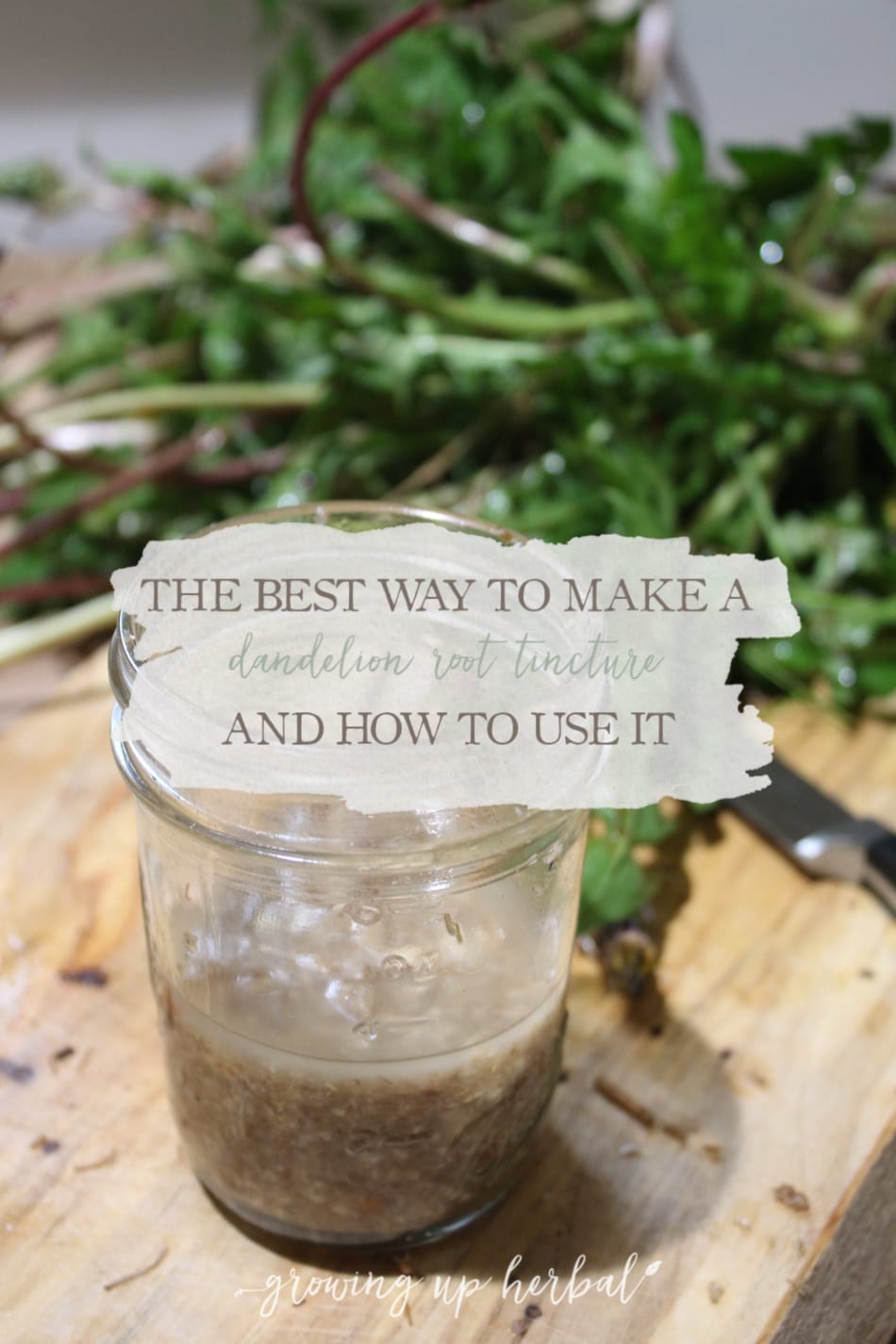
Dandelion (Taraxacum officinale) is by far my favorite plant. Every part of it can be used in herbalism, but in this article, I’m focusing on using the root of dandelion only.
Below I’ll share 10 dandelion root wellness benefits as well as explain how to harvest the root and use it to make a simple dandelion root tincture.
If you’ve ever wanted to learn more about using an herb that is available almost everywhere in the world and has a lot of uses, dandelion is it!
10 Dandelion Root Wellness Benefits
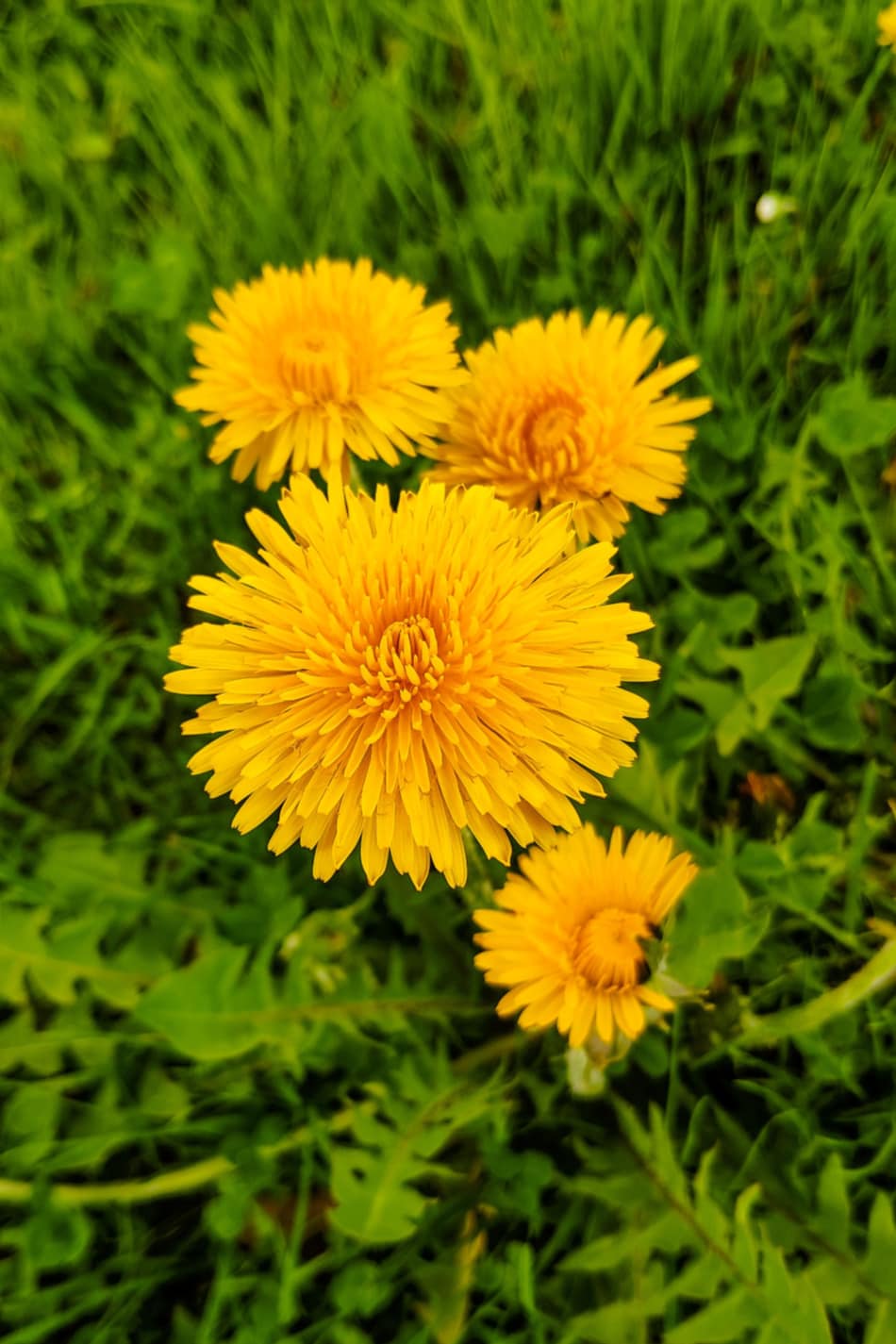
Dandelion not only has an extensive history of use around the world, but it’s also heavily researched in medical literature, primarily for its anti-cancer properties. Dandelion root wellness benefits certainly extend beyond this, though.
Below, I’m sharing 10 dandelion root wellness benefits that may be able to offer support to your body.
1. Cancer Prevention and Support
A lot of the recent scientific studies on dandelion are focused on its ability to help with cancer. Even aggressive forms of cancer that don’t respond well to conventional treatments showed promising results with dandelion root.
Pediatric Cancer
A team of researchers noted that dandelion already shows activity against adult cancers, so they wanted to track the effect on pediatric cancers. A 2018 study was conducted that looked at dandelion root’s effect on cancer in children revealing that a water-based, fermented dandelion extract showed positive anti-tumor effects on pediatric cancer cell lines and was even more effective when paired with mistletoe extract (Menke et al., 2018).
Breast Cancer
A 2018 animal study used a dandelion root extract in mice with breast cancer which showed suppression of breast cancer growth and cancerous cell proliferation. Researchers concluded the extract was effective as an anti-cancer herbal agent in this situation (Nassan et al., 2018).
Stomach Cancer
Stomach cancer is a rare disease with a survival rate of only 30-65% (University of Rochester Medical Center, 2018). In a 2017 study, a team of researchers found that dandelion root extract reduced the multiplication and spread of cancer cells in the stomach, and unlike conventional cancer treatments, didn’t harm the normal cells (Zhu et al, 2017).
Pancreatic Cancer
Pancreatic cancer has a near 100% mortality rate, and there are usually no symptoms until the disease is in the late stages (Mayo Clinic, 2018). In a 2012 study, a water-based dandelion root extract was shown to trigger the body to kill and remove cancerous pancreatic cells, with no harm to healthy pancreas cells (Ovadje et al., 2012a).
Leukemia
Researchers from the University of Windsor in Canada studied dandelion root extract’s effect on a highly aggressive and treatment-resistant leukemia. Patients typically only survive 1-2 years after diagnosis even with conventional treatment. Within 4 days, 60% of the cancer cells were negatively affected by the dandelion root extract, and after another 48 hours of treatment, cancer cell death occurred in the remaining cancer cells (Ovadje et al, 2012b). It’s important to note that this study was done on test plates and not in the human body, but it still shows promise.
Before moving on to more wellness benefits of dandelion, it’s important to note that most of these studies are preliminary and done in a petri dish in a lab or in animals. While they show promising results, we can’t conclude from them that dandelion is the right choice for support for everyone’s cancer. However, dandelion is an antioxidant (Lobo et al., 2010) and helps support healthy detoxification in the body, both of which are very important for preventing diseases, including cancer.
2. Protect Brain Health
A 2018 study published in the journal Nutrients looked at dandelion root extract’s effect on the brain. The extract contained antioxidants that help prevent brain degeneration and related disorders by protecting brain cells from oxidative stress, and researchers concluded that dandelion may help prevent neurodegenerative diseases, like Alzheimer’s or Parkinson’s disease (Huang et al., 2018).

3. Clearer Skin
Dandelion has been traditionally used for chronic skin disorders that stem from a poorly functioning liver. The liver is responsible for removing toxins, synthesizing proteins, and playing a role in hormone regulation in the body. When the liver isn’t performing these tasks properly, it often manifests as a skin problem (Hazin et al., 2009). Using dandelion regularly can help to support healthy liver function, which I’ll talk more about below, which in turn, supports clearer skin.
4. Better Liver Function
One of the most popular ways to use dandelion tincture is to support the liver’s detoxification pathways. Our liver works hard to handle everyday toxin exposures, and dandelion can give it some additional support in that area so it functions as it should.
Traditional Chinese Medicine (TCM) uses dandelion to “calm fire” in the liver, to support detoxification, and for chronic liver conditions like hepatitis. Dandelion has also traditionally been used in cases of chronic jaundice, which stems from a poorly functioning gallbladder and liver (Herbal Academy, n.d.).
Since alcohol is metabolized by the liver, a dandelion tincture is one of the best ways to get dandelion’s liver supportive properties directly to the source (Brown University, n.d.).
5. Acetaminophen Recovery
Tylenol (acetaminophen) is one of the most popular over-the-counter pain medications for adults, children, and infants. However, this commonly used drug can lead to liver damage in even typical doses.
In America, Acetaminophen overdose sends many people to the emergency room each year, leading to hospitalization and a long road to recovery, making this easy-to-access drug the nation’s leading cause of acute liver failure (Mosbergen, 2017).
Several animal studies have shown that both dandelion root and leaf extracts have hepatoprotective effects against acetaminophen (Cai et al., 2017; Colle et al., 2012; Ren et al, 2020). While I like to choose safer pain relief options, sometimes that’s not possible. When my husband was hospitalized with acute pancreatitis, he was given high doses of Tylenol for pain management. Afterward, he took dandelion to help support liver recovery.
6. Better Gallbladder Function
The gallbladder is a small sac at the base of the liver and produces bile that helps the body digest fat. While 10-20% of Americans experience gallstones, most of the time, there aren’t any symptoms. Gallbladder disease used to be rare in children; however, it has become a growing problem, mostly because of the rise in child obesity (Stinton & Shaffer, 2012). Dandelion not only helps liver function, but it keeps the gallbladder functioning smoothly.
According to herbalist Matthew Wood, dandelion enhances bile flow, reduces bile duct inflammation, and helps prevent gallstones (Wood, 2008). Dandelion is useful when bile is stagnant as it helps get things moving, making it a slow, gentle cleanse for the liver, gallbladder and pancreas (Wood, 2008).
A note of caution when it comes to using dandelion for gallbladder function: If a gallstone is stuck in the bile duct or the gallbladder is inflamed, then dandelion should not be used as it will make this situation worse!

7. Improves Digestion and Acid Reflux Symptoms
Herbal bitters, like dandelion, work to stimulate digestion which can help address a variety of digestive issues.
Initially, when the bitter taste of dandelion hits the tongue, it stimulates saliva production which starts the digestion of starches and fats in the mouth.
Bitters also stimulate the hormone gastrin, which regulates hydrochloric acid (HCL) production in the stomach. As we age, stomach acid levels naturally decline which can lead to symptoms of acid reflux. Instead of dampening acid production by taking antacids or supplementing with HCL, bitters can help the body regulate stomach acid production before further measures are needed.
Bitters also stimulate the body to make the enzyme pepsin, which helps us digest protein and absorb vitamin B12 (mcdonald, n.d.).
“Perhaps it is not right to think that bitters should be used to treat sluggish digestion, but that a lack of bitter flavor in one’s diet can be a cause of sluggish digestion.” – jim mcdonald
8. Can Help Prevent Constipation
If you’re finding it hard to go to the bathroom, dandelion may work as a gentle laxative to prevent constipation. Maybe, but not always. Read on to find out if dandelion is a fit for you in this area.
Bitters not only stimulate digestive juice secretion in the small intestine and tone colon muscles to help push stool through the bowels, but they also have positive effects on the liver and gallbladder, helping the body produce adequate bile to prevent dryness in the intestines (mcdonald, n.d.). Because of this, dandelion may be helpful to some in cases of constipation.
On the other hand, dandelion may cause constipation for some. Some bitters can be drying because they stimulate bodily secretions that encourage fluids to be flushed from the body. Dandelion is a diuretic and increases urine output. If dandelion alone is too drying for someone, then moistening and warming herbs can be added to create a balanced formula. Some moistening herbs include licorice (Glycyrrhiza glabra) and fenugreek (Trigonella foenum-graecum), though the best herb choice will depend on the person and condition being addressed (mcdonald, n.d.).
When approaching constipation with herbs, herbalist jim mcdonald often recommends combining dandelion root with orange peel and ginger. The ginger is warming to counteract the cooling effects dandelion can have and is another great digestive herb.
9. Reduce Sugar Cravings
Most of us don’t consume many bitter foods like dandelion any more, but in the past, bitter foods have been an integral part of the diet. Sweet or salty foods are what line grocery store shelves, but these refined foods are lacking in the natural bitter flavor our bodies need.
According to herbalist jim mcdonald, in their natural form, most sweet flavors are associated with a degree of bitterness (some sweet foods and herbs are so sweet they’re almost bitter, such as pure sugarcane, licorice root, and stevia (Stevia rebaudiana) leaf) (mcdonald, n.d.). However, when these sweet flavors are refined, all bitter flavor is removed entirely. According to jim, sweet cravings are the body’s way of asking us for bitters, and these cravings can often be sated by tasting things that are bitter (mcdonald, n.d.).
Bitters also help us let go of trapped emotional energies, which is partly associated with sluggish liver function which can further help abate sweet cravings brought on by emotional eating habits (mcdonald, n.d.).
10. Fights Harmful Pathogens
A study published in the journal, Phytotherapy Research, showed that dandelion root extract helped fight the bacterial strains methicillin-resistant Staph aureus (MRSA), Bacillus cereus, and Staph aureus—pathogens that can cause a variety of serious health issues (Kenny et al., 2015). Traditional Chinese Medicine also uses dandelion during viral infections like the flu (Tillotson, 2001).
As you can see, dandelion can help to keep the body functioning properly. When the immune system, digestion, and detox pathways are all working in harmony, the body is stronger and better able to handle harmful pathogens. So not only does dandelion discourage harmful microbes in the body, but it also helps the body be more resistant to them in the first place.
Now that you know some dandelion root wellness benefits, let’s look at how to go about harvesting dandelion and using it to make a tincture.
The Best Way to Harvest Dandelion Root
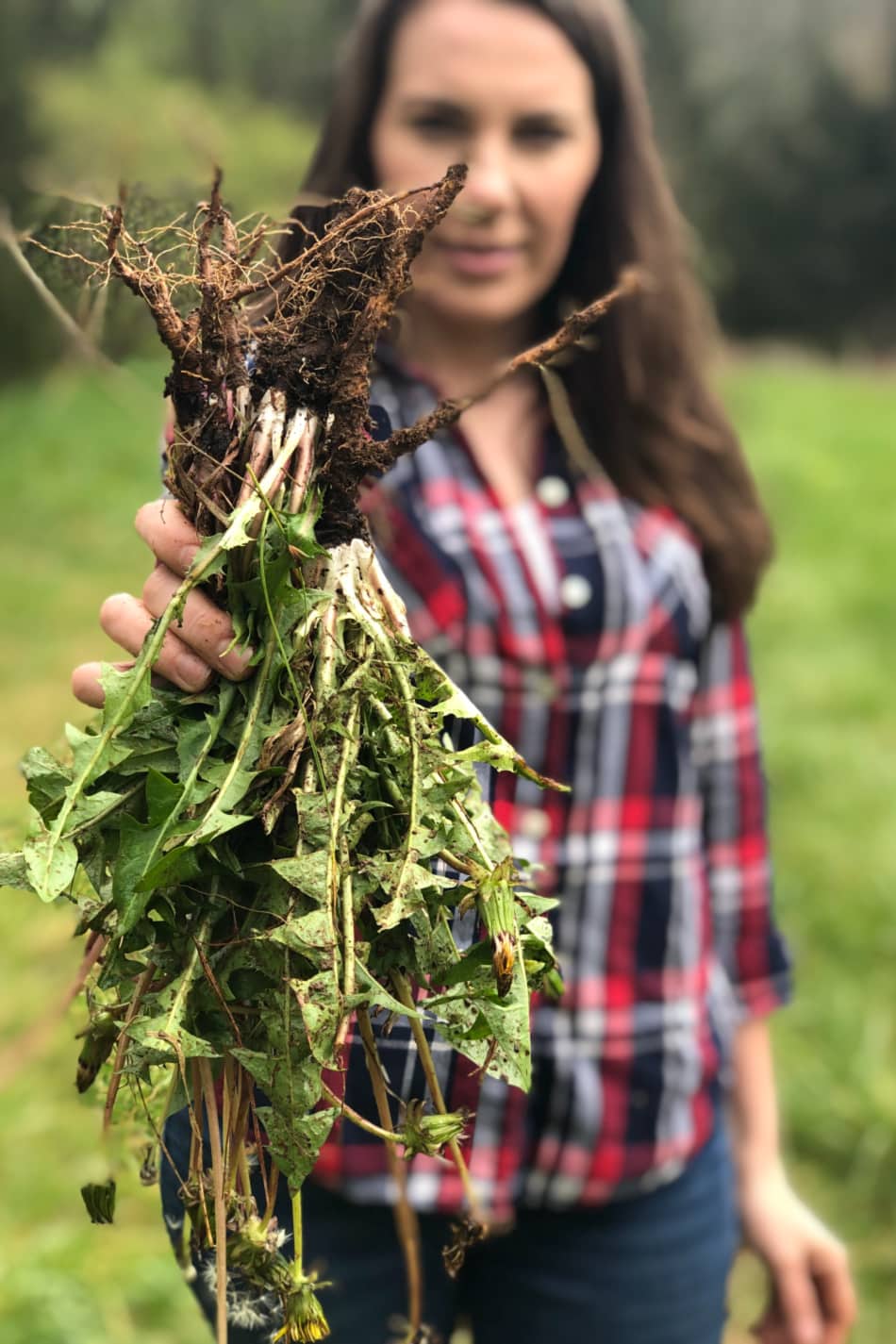
Dandelions grow just about everywhere, but it’s important to choose the right dandelion root when you plan to use it for wellness purposes.
Plants that grow near farm fields, golf courses, and roadsides shouldn’t be used since these areas are highly contaminated with pesticides and environmental toxins. A 2018 study showed that dandelions grown near roads were contaminated with toxins from passing cars. The highest concentration of these toxins is in the roots, but contaminants are still present in high amounts in the leaves and flowers. The further the plants were from the road, the less of these toxins they had (Mleczek et al., 2018).
Finding a field or off the beaten path where dandelion is growing is your best bet at harvesting a healthy root!
Dandelion has a long taproot, so you’ll likely need a shovel to dig down and around the plant to get it out of the ground. If you try to pull it or if you don’t dig deep enough, you’ll break the root. It may also be helpful to have a pitchfork-like tool to help you lift the dandelion from the ground and loosen it from the soil after you’ve dug around it.
Once you’ve harvested the root, you’ll want to wash the root thoroughly to remove all dirt from it. You can then use it fresh or dry it for storage.
Click here to read even more about how to properly wildcraft herbs!
When to Harvest Dandelion Root
Dandelion roots are more bitter and stimulating to the body in the spring. When harvested in the fall, the root is sweeter and more nourishing to the body because it is higher in inulin and starches (Herbal Academy, n.d.). With that said, the best time to harvest the root will depend on the dandelion root wellness benefit you want to obtain from the plant. If you want to harness the root’s bitter properties, harvest roots in spring. If you want to harness the roots sweeter and starchier properties, harvest it during fall.

Dandelion Root Preparations: Which Should You Use
The chemical constituents of dandelion root include: taraxacin, acrystalline, taraxacerin (an acrid resin), inulin, gum, and potash, and in the spring the bitter soluble taraxacin is highest (Chhabra, n.d.) as well as vitamins A and B and minerals such as calcium, potassium, iron (Herbal Academy, n.d.).
Both water- and alcohol-based preparations, such as infusions and tinctures, are made using dandelion root, but sugar-based preparations, like syrups, can also be used.
Fall harvested dandelion root tea has a delicious flavor, and when made from spring-harvested roots that have been roasted, dandelion tea is commonly used as a coffee substitute. These water-based preparations are great for extracting mucilage, gums, vitamins, and minerals from dandelion root.
However, when the root is made into an alcohol tincture, the extracted properties are slightly different than when used in water-based preparations. Since a tincture uses liquid that’s a mixture of alcohol and water, it can extract both the water and alcohol soluble constituents from the plant such as alkaloids, acrid and bitter properties, glycosides, organic acids, resins, and volatile oils (Green, 2000).
When it comes to using spring harvested dandelion root, my preferred preparation is a tincture.
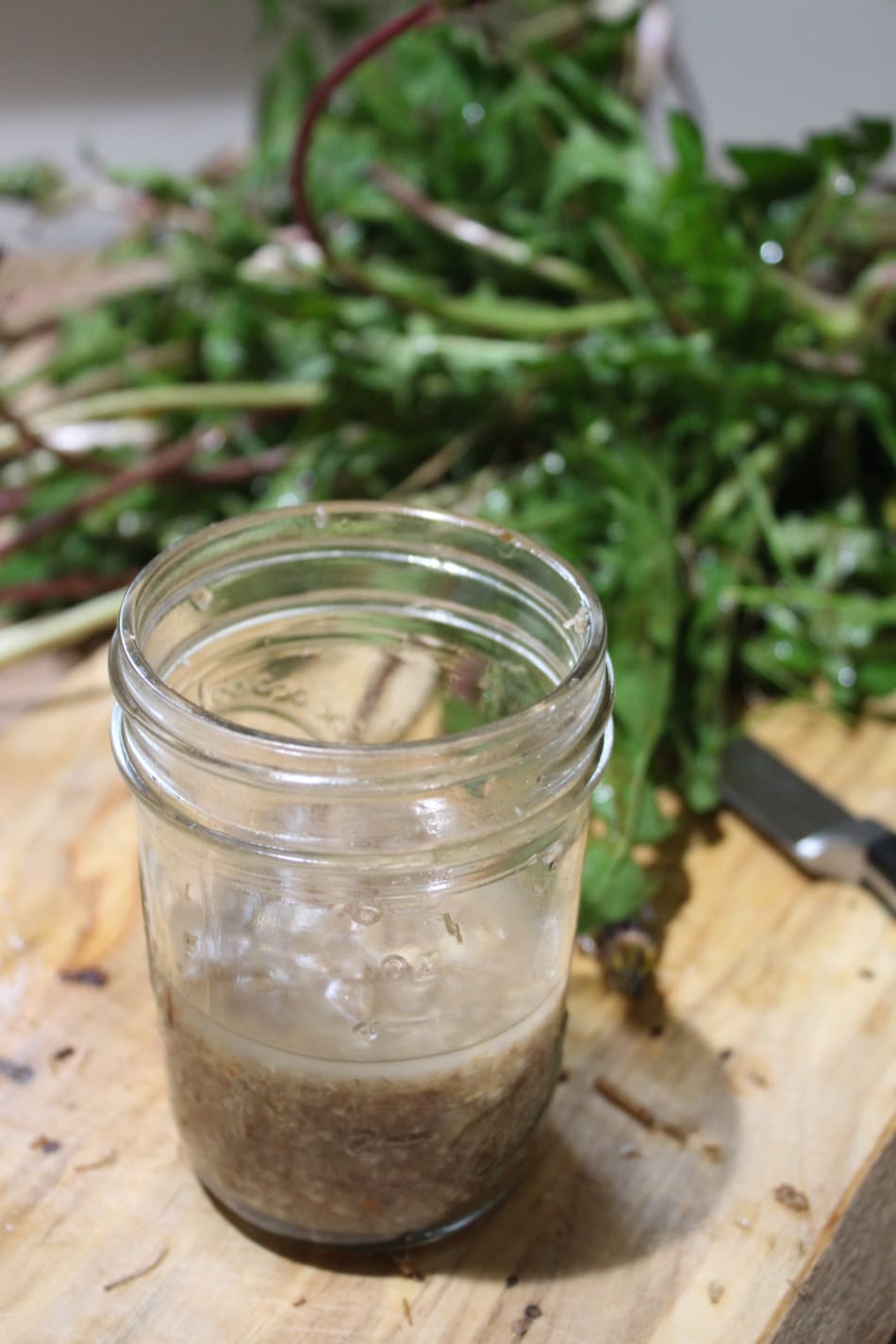
The Best Way to Make a Dandelion Root Tincture
Tinctures are concentrated plant preparations, which means a smaller dose is needed and the preparation can be stored much longer than a tea. As a busy mom with little ones, anything that’s more convenient (and still healthy!) is a plus!
There are different opinions on how to make tinctures, but I prefer to do a ratio tincture, also known as a weight-to-volume tincture. This method measures the amount of herb used by weight and the liquid, or menstruum used, by volume.
Unlike the folk method where you eyeball the measurements of plant and liquid in a jar, a ratio tincture is more precise and has more accurate dosing.
Since roots are more dense than the leaves or flowers of a plant, I’m doing a 1:4 ratio to better extract the constituents from the plant material. Companies with the necessary equipment are able to do stronger 1:1 or 1:2 ratios, but that’s much more difficult for home preparations.
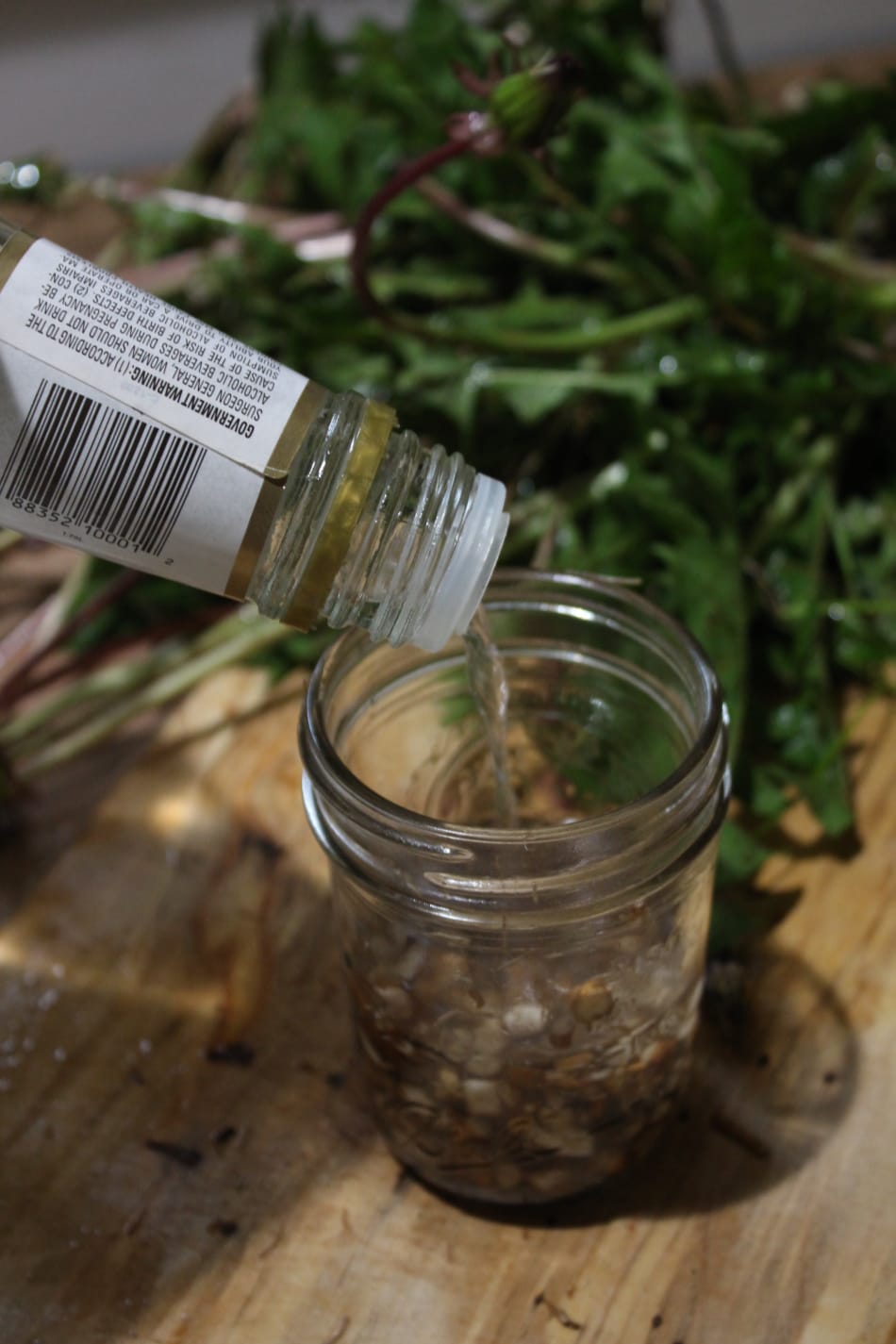
Why different Alcohol Strengths?
Since fresh plant material contains more water than dried, I’m using a higher ratio of alcohol. If all you can find is 80 proof alcohol though, it will still work fine. The end result just won’t be quite as strong. If dandelion isn’t in season, or you don’t have access to a clean source, then you can also use the dried root (Mountain Rose Herbs is a great source for dried herbs), although fresh is preferred.
Let’s look at how to make a dandelion root tincture using either fresh or dried dandelion root.
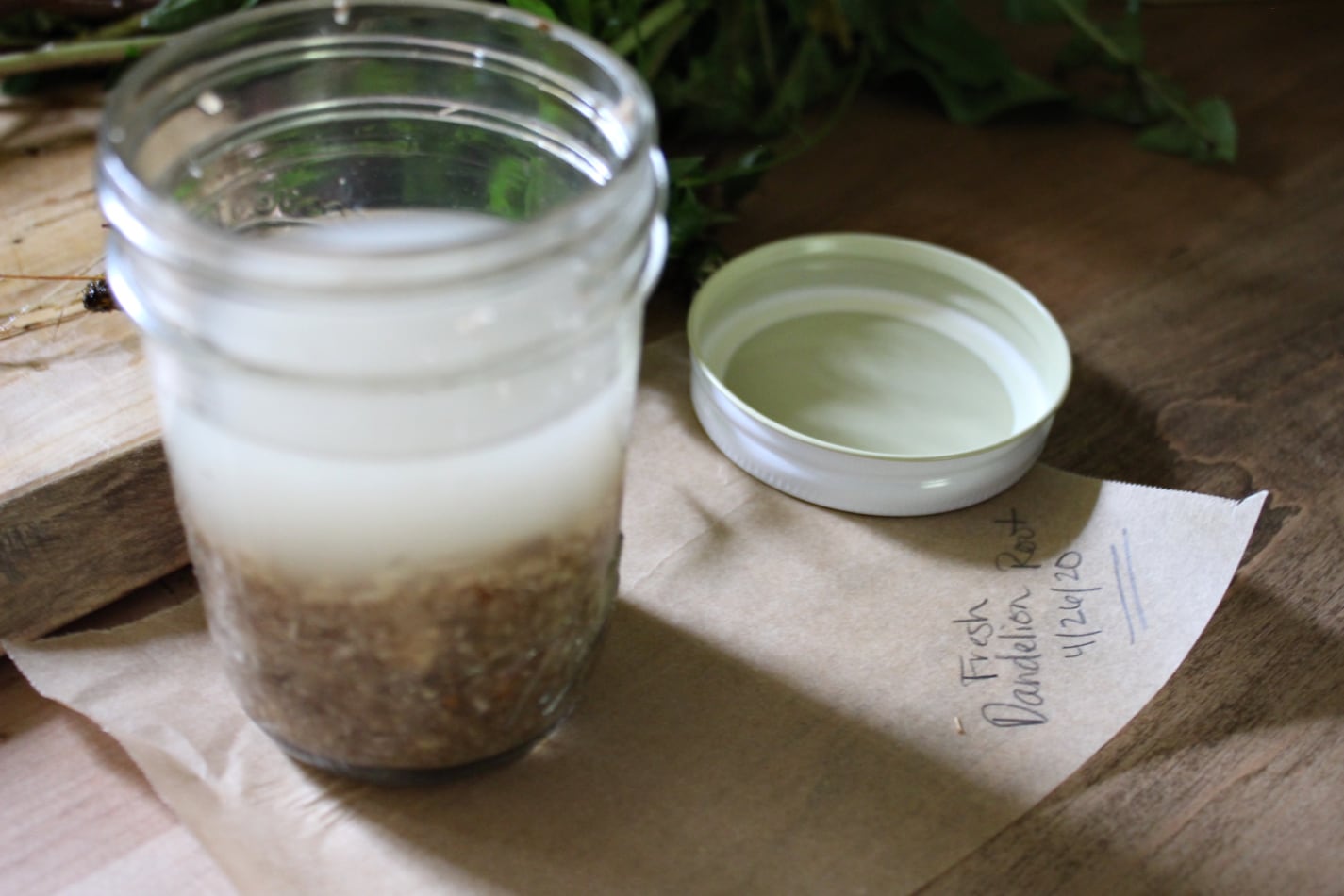
How to Make a Dandelion Root Tincture
Ingredients:
- 1-ounces (by weight) of fresh or dried dandelion root (fresh is preferred)
- 4-ounces (by volume) of a 190 proof alcohol if using fresh root or 80 proof vodka or brandy if using dried root
- Sharp chopping knife
- Blender
- Glass canning jar
- Funnel
- Cheesecloth
- Dropper bottles
Directions:
- If using fresh dandelion root, wash the root thoroughly to remove all dirt before slicing or chopping into small pieces. Place the fresh root pieces and the alcohol into a blender and pulse until well mixed. If you don’t have a blender, then just chop the fresh root as fine as you can with a knife. The more surface area of your herb that’s exposed to the alcohol, the better.
- If using dried dandelion root, simply combine the herb and alcohol together in a glass jar, skipping the blender, and move on to step three.
- Pour the root and alcohol into a glass canning jar. Put a piece of parchment paper between the jar and the lid, and store in a cool, dark place for 6-8 weeks, shaking every so often.
- Once the tincture has steeped, use a layered cheesecloth-lined funnel to strain out the herb. Squeeze the cheesecloth after straining to get as much of the liquid out as possible.
- Compost the herb, and store the finished tincture in a labeled glass bottle with a dropper top in a cool, dark location.
Dosage:
The dosage will depend on the person and condition being addressed. A good starting guideline is to take 20-40 drops (1-2 mL or roughly 1-2 droppers) 1-4 times a day. The tincture can be put into alcohol, tea, or juice.

Using Dandelion Root Tincture for Children
In case you’re wondering, yes, alcohol tinctures are safe for children. I cover all the details about that in this post here. If you feel like your child would benefit from a dandelion root tincture, then the adult dose given above should be adjusted for their age and weight. You can find the dosing rules I use to do that here.
Who Should Not Use Dandelion Root Tincture?
Dandelion is overall a very safe herb and is generally considered safe for children, during pregnancy, and while breastfeeding. However, if you are pregnant, it is always a good idea to consult your health care provider before using an herb.
Dandelion should not be used by those with bile duct obstruction or when the gallbladder is acutely inflamed. Personally, I’ve used it as a gentle gallbladder tonic when there’s sludge, but no stones blocking the area. While dandelion helps with constipation, it shouldn’t be used in cases of bowel blockage (Tilgner, 2009).
Another reason to skip using dandelion root tincture is if you’re dealing with a condition that is energetically cold and dry. I touched on this a bit when I spoke about the dandelion root wellness benefit of easing constipation—or sometimes not! Because dandelion is a cooling, drying herb, it’s best when used for conditions that are hot and moist in nature. If you use dandelion for a condition that is already cool and dry, you may exacerbate your symptoms and end up feeling worse!
Where to Buy Dandelion Root Tincture
If you’re not interested in making your own dandelion root tincture, you can purchase it from Mountain Rose Herbs or on Amazon from Herb Pharm.
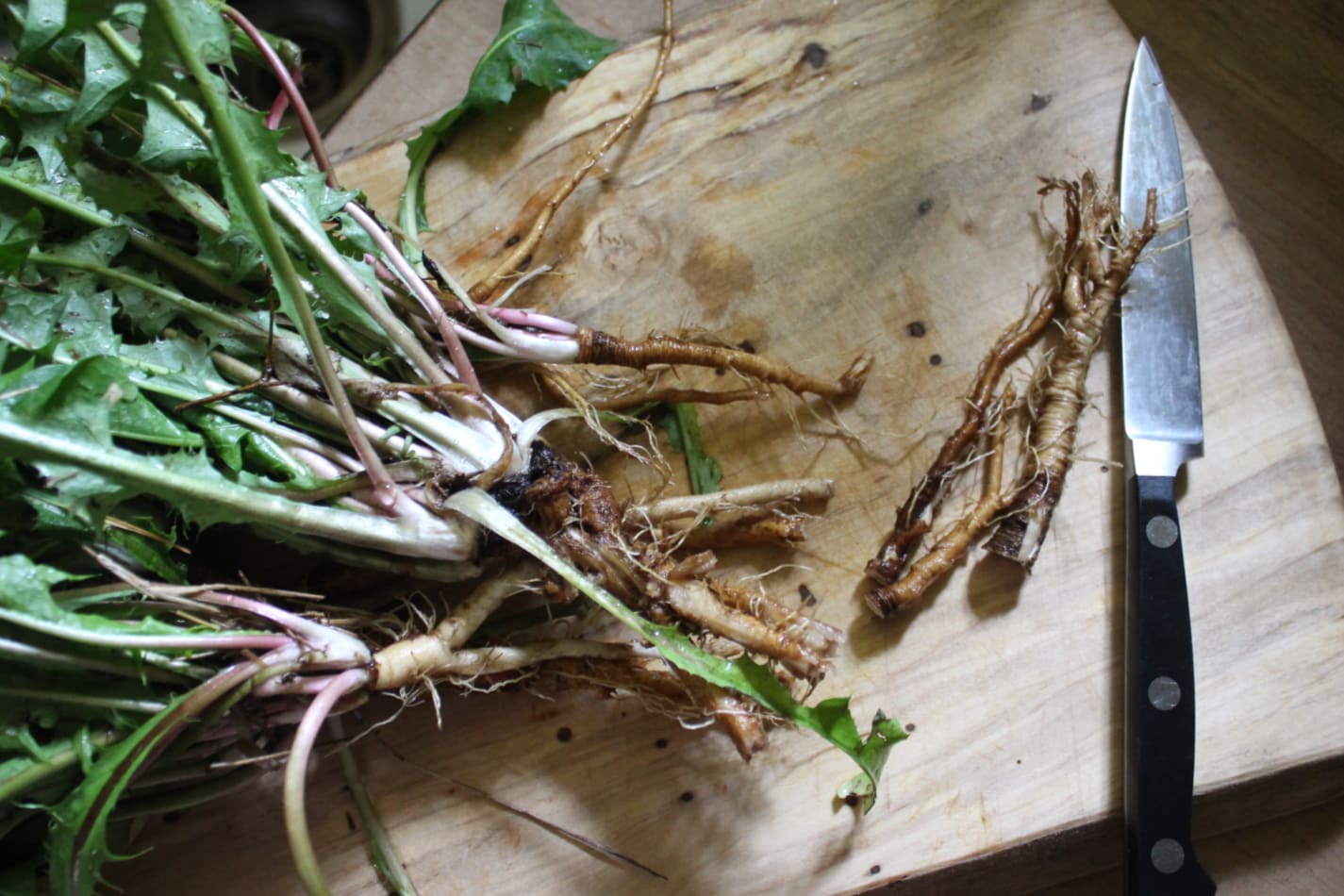
In Closing
As you can see, dandelion is an herb that is truly beneficial for one’s health in a multitude of ways—the spring root of this plant being particularly helpful for digestive and liver support, and the fall root helpful for gut microbial balance.
How will you incorporate dandelion into your wellness routine?
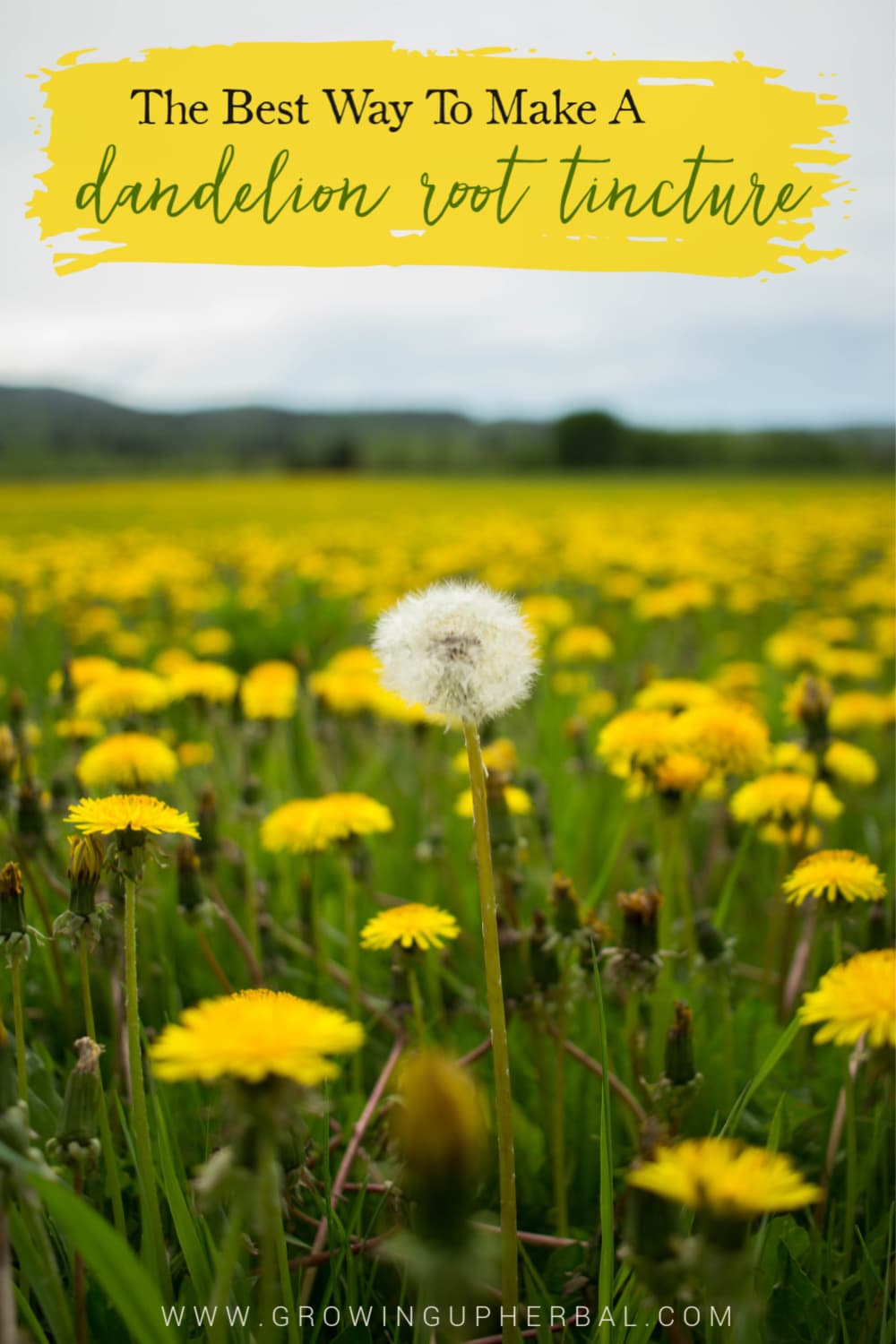
REFERENCES:
Brown University. (n.d.). Alcohol and your body. Retrieved from https://www.brown.edu/campus-life/health/services/promotion/alcohol-other-drugs-alcohol/alcohol-and-your-body
Cai, L., Wan, D., Yi, F., & Luan, L. (2017). Purification, preliminary characterization and hepatoprotective effects of polysaccharides from dandelion root. Molecules, 22(9), 1409. http://doi.org/10.3390/molecules22091409
Chhabra, Y. (n.d.) The benefits of the use of dandelion in herbal preparations: Chemical constituents of dandelion. Retrieved from http://www.herballegacy.com/Chhabra_Chemical.html
Colle, D., Arantes, L.P., Gubert, P., da Luz, S.C., Athayde, M.L., Teixeira Rocha, J.B., Soares, F.A. (2012). Antioxidant properties of Taraxacum officinale leaf extract are involved in the protective effect against hepatoxicity induced by acetaminophen in mice. Journal of Medicinal Food, 15(6), 549-556. http://doi.org/10.1089/jmf.2011.0282
Green, J. (2000). The herbal medicine maker’s handbook: A home manual. Berkeley, CA: Crossing Press.
Hazin, R., Tamimi, T., Abuzetun, J., & Zein, N. (2009). Recognizing and treating cutaneous signs of liver disease. Cleveland Clinic Journal of Medicine, 76(10), 599-606. http://doi.org/10.3949/ccjm.76A.08113
Herbal Academy. (n.d.). Dandelion monograph. Retrieved from https://herbarium.theherbalacademy.com/monographs/#/monograph/1009
Huang, S., Meng, N., Liu, Z., Guo, L., Dong, L., Li, B., & Ye, Q. (2018). Neuroprotective effects of Taraxacum officinale wigg. extract on glutamate-induced oxidative stress in HT22 cells via HO-1/Nrf2 pathways. Nutrients, 10(7), 926. http://doi.org/10.3390/nu10070926
Kenny, O., Bruntun, N., Walsh, D., Hewage, C., McLoughlin, P., & Smyth, T. (2015). Characterisation of antimicrobial extracts from dandelion root (Taraxacum officinale) using LC-SPE-NMR. Phytotherapy Research, 29(4), 526-532. http://doi.org/10.1002/ptr.5276
Lobo, V., Patil, A., Phatak, A., & Chandra, N. (2010). Free radicals, antioxidants and functional foods: Impact on human health. Pharmacognosy reviews, 4(8), 118-126. http://doi.org/10.4103/0973-7847.70902
Mayo Clinic. (2018). Pancreatic cancer. Retrieved from https://www.mayoclinic.org/diseases-conditions/pancreatic-cancer/symptoms-causes/syc-20355421
Menke, K., Schwermer, M., Felenda, J., Beckman, C., Stintzing, F., Schramm, A., & Zuzak, T. (2018). Taraxacum officinale extract shows antitumor effects on pediatric cancer cells and enhance mistletoe therapy. Complementary Therapies in Medicine, 40, 158-164. http://doi.org/10.1016/j.ctim.2018.03.005
mcdonald, j. (n.d.) Blessed bitters. Retrieved from http://herbcraft.org/bitters.pdf
Mleczek, P., Borowiak, K., Budka, A., & Niedzielski, P. (2018). Relationship between concentration of rare earth elements in soil and their distribution in plants growing near a frequented road. Environmental Science and Pollution Research International, 25(24), 23695-23711. http://doi.org/10.1007/s11356-018-2428-x
Mosbergen, D. (2017). Tylenol overdose risk is staggering; Acetaminophen safeguards remain insufficient. Retrieved from https://www.huffpost.com/entry/tylenol-overdose_n_3976991
Nassan, M., Soliman, M., Ismail, S., & El-Shazly, S. (2018). Effect of taraxacum officinale extract on PI3K/Akt pathway in DMBA induced breast cancer in albino rats. Bioscience Reports, 38(6), BSR20180334. http://doi.org/10.1042/BSR20180334
Ovadje, P., Chochkeh, M., Akkbari-Asl, P., Hamm, C., & Pandey, S. (2012a). Selective induction of apoptosis and autophagy through treatment with dandelion root extract in human pancreatic cancer cells. Pancreas, 41(7), 1039-1047. http://doi.org/10.1097/MPA.0b013e31824b22a2
Ovadje, P., Hamm, C. & Pandey, S. (2012b). Efficient induction of extrinsic cell death by dandelion root extract in human chronic myelomonocytic leukemia (CMML) cells. PLoS ONE, 7(2), e30604. http://doi.org/10.1371/journal.pone.0030604
Ren, Y.S., Zheng, Y., Duan, H., Lei, L., Deng, X., Liu, X.Q., Mei, Z.N., & Deng, X.K. (2020). Dandelion polyphenols protect against acetaminophen-induced hepatotoxicity in mice via activation of the Nrf-2/HO-1 pathway and inhibition of the JNK signaling pathway. Chinese Journal of Natural Medicines, 18(2), 103-113. http://doi.org/10.1016/S1875-5364(20)30011-X
Tilgner, S. (2009). Herbal medicine from the heart of the earth (2nd ed.). Pleasant Hill, OR: Wise Acres LLC.
Tillotson, A.K. (2001). The one earth herbal sourcebook. New York, NY: Kensington Publishing Group.
University of Rochester Medical Center. (2018). Stomach cancer. Retrieved from https:www.urmc.rochester.edu/cancer-institute/cancers/stomach.aspx
Wood, M. (2008). The earthwise herbal: A complete guide to Old World medicinal herbs. Berkeley, CA: North Atlantic Books.
Zhu, H., Zhao, H., Zhang, L., Xu, J., Zhu, C., Zhao, H., & Lv, G. (2017). Dandelion root extract suppressed gastric cancer cells proliferation and migration through targeting IncRNA-CCAT1. Biomedicine & Pharmacotherapy, 93, 1010-1017. http://doi.org/10.1016/j.biopha.2017.07.007
Hi, this is a great post on making a dandelion tincture. I am wondering if using ACV instead of alcohol would be more beneficial to extract the healthy minerals and make it more kid friendly. Have you tried this? Any thoughts or feedback would be great, thank you!
~Chantal
You can definitely make an herbal vinegar with dandelion root, and yes, it will extract more of the minerals. The solvent you use is based on what you’re trying to get from the herb. For nutrients, I’d suggest water or vinegar extracts. For the liver and digestive supportive properties, glycerine or alcohol will work. If you choose to use vinegar, dried dandelion root is best. If you use fresh root, it will dilute the vinegar a bit, which could reduce its shelf-life, so you’ll want to store the finished vinegar in the fridge until you use it all. Hope all of that makes sense! If not, feel free to reach out with more questions. I’m happy to answer!
Thank you for the very detailed an informative article. When looking to purchase dandelion extract to treat sludge in the gallbladder what size bottle is recommended to complete a course of detox? Are the dandelion root extract capsules comparable in efficacy to the tincture? Advanced thanks for reply. Well Wishes, Alex
I prefer tinctures when using bitters or herbs that work on the liver or gallbladder tissues. Bitters is something I recommend everyone taking all the time, day in and day out as that will provide you with the best support for the liver/gallbladder tissues. However, if you’re only interested in using it for a short period of time, six months would be ideal.
Curious as to your thoughts on using dandelion tincture to help block the SARS-CoV-2 spike proteins. There is an article at food is medicine dot com. The name of the article is: RESEARCH: Dandelion leaf extract blocks spike proteins from binding to the ACE2 cell surface receptor. Is dandelion leaf extract an entirely different thing and have you tried making that? I’m new to this (and a fellow homeschooling mama).
Hey, Mary. Thanks for sharing. I’ll have to look into this article a bit further. It sounds interesting. And yes, you can totally make a tincture from dandelion leaf instead of the root. The leaf is most often used for urinary support and adding minerals to the body, but I’m sure there are many other benefits to it as well.
Hi Meagan, I had my gallbladder removed 27 years ago. Can I still take the dandelion tincture for health benefits and against the spike protein in the covid vaccine? Where can I buy the 190 proof alcohol?
Thankyou very much for the article!!!!
Diana
Yes, you can still use a dandelion tincture without a gallbladder. As far as where to purchase the alcohol, you can check with local liquor stores, you can order it online, or you can purchase a premade dandelion tincture from companies like Herb Pharm or Oregon’s Wild Harvest.
How long can you keep the dandelion root tincture? I’ve had my brewing for 4 months and ready to strain for use. I will put in a dropper and store in the refrigerator. I am ready to do some fall dandelion root hunting also. Any suggestions?
Dandelion tinctures made with alcohol are shelf-stable (no refrigeration required) and will last 3-5 years, if not longer! Goog luck with your autumn dandelion root harvest!
I see that this is a few years old but thought I would still ask, I see you listed gluten as a constituent of the dandelion. Would this not be safe for someone with celiac disease? Also, love the depth of info in your blog!
Hey Tina. This was a guest post, so I looked into the source that says dandelion contains gluten, and it’s from the Dr. Christopher site. However, gluten is a substance found in grains, not vegetables or herbs, and after doing some research, I can’t find any other source that says dandelion root contains gluten. In fact, most companies that sell it advertise that it’s gluten-free. With that said, I’m not sure where the information on the Dr. Christopher site came from that led them to believe dandelion contains gluten, but I’m removing it from the article as I’m quite certain that is incorrect. Sorry for the confusion, but thank you for bringing the question up!
I just found out that some alcohol is made from grains, which can be problematic for people with gluten issues. Google which alcohol you are using to be safe. I had to find a new vodka. Thank you for your great website.
Yes! If you have a gluten sensitivity or allergy, then you will definitely want to look for alcohol made with fruit, potatoes, or something other than grains. And I’m glad you’re enjoying the website! I hope you’re finding it helpful!
Hi, just strained my first batch of dandelion tincture. I wasn’t able to get as many roots as I’d hoped, it’s mostly from flowers, a few roots and some baby leaves. What would you say my tincture is good for? My cousin is dying from cancer in her spine(tumor), liver, lungs and breasts. Would my tincture help her? If so how much should she take? I used vodka and seeped for 3-4 months. Thx!
Your tincture would be beneficial in many ways, Rachael, but unfortunately, I can’t give specific suggestions for people without working with them individually. I’d encourage you (or your cousin) to reach out to a clinical herbalist for specific help and to do further research on the benefits of dandelion. Best of luck.
I just find your article online. I am a medicinal plants foragers for less than 2 years. I could find some interesting information that added things to my understanding on the dandelion tinctures, thank you for that.
I have a question;
With which tincture can I pair up Dandelion tinctures with ( I have these tinctures: Yarrow, Nettle, Goldenrod , Plantain, Turkey Tails, and Elderberry)
If there are some references information where I can have tap for handling multiple tinctures
Thank you for your feedbacks
You can definitely formulate with tinctures. I’d highly recommend the Tincture Making 101 Mini Course if you want to learn more about creating your own tincture blends. It’s fantastic!
I just bought 100 proof vodka, is this enough to make a good dandelion tincture?
Thank you,
Yes, that would contain 50% alcohol, which is appropriate for dandelion root. However, if you’re using fresh dandelion root, just know that the moisture in the fresh root will lower the alcohol percentage a bit. As long as it doesn’t drop below 25% ABV, the tincture will be shelf stable.